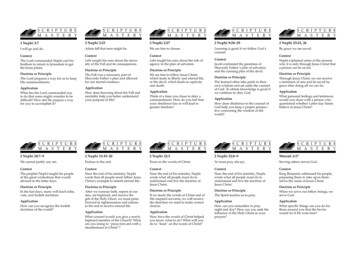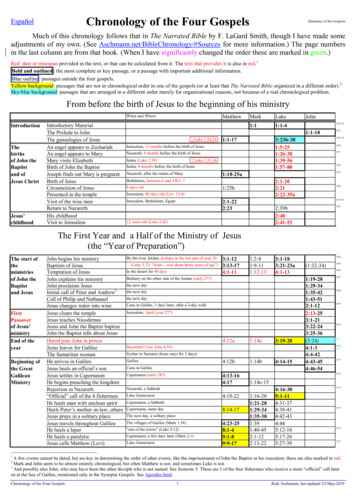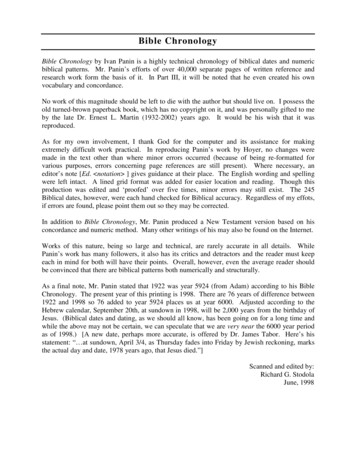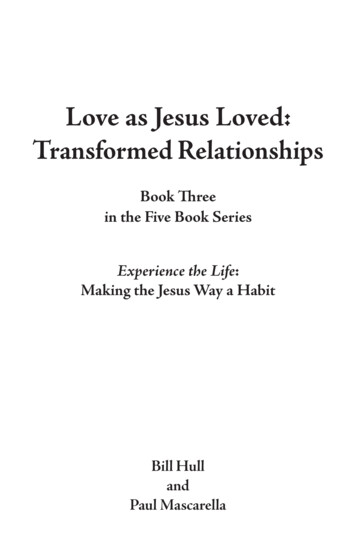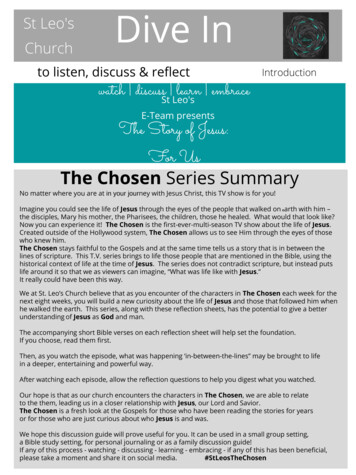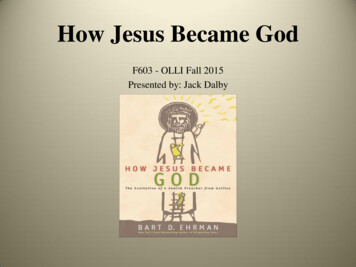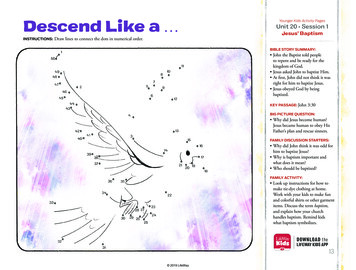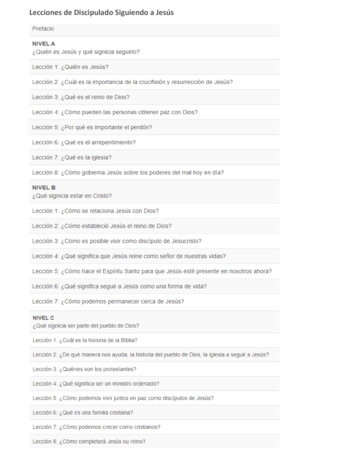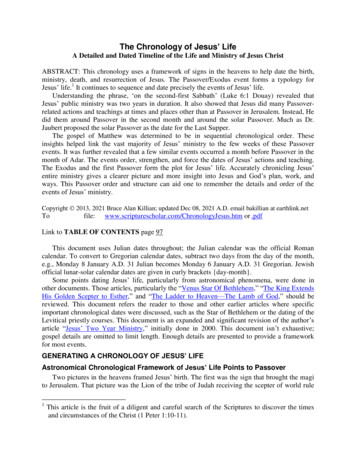
Transcription
The Chronology of Jesus’ LifeA Detailed and Dated Timeline of the Life and Ministry of Jesus ChristABSTRACT: This chronology uses a framework of signs in the heavens to help date the birth,ministry, death, and resurrection of Jesus. The Passover/Exodus event forms a typology forJesus’ life.1 It continues to sequence and date precisely the events of Jesus’ life.Understanding the phrase, ‘on the second-first Sabbath’ (Luke 6:1 Douay) revealed thatJesus’ public ministry was two years in duration. It also showed that Jesus did many Passoverrelated actions and teachings at times and places other than at Passover in Jerusalem. Instead, Hedid them around Passover in the second month and around the solar Passover. Much as Dr.Jaubert proposed the solar Passover as the date for the Last Supper.The gospel of Matthew was determined to be in sequential chronological order. Theseinsights helped link the vast majority of Jesus’ ministry to the few weeks of these Passoverevents. It was further revealed that a few similar events occurred a month before Passover in themonth of Adar. The events order, strengthen, and force the dates of Jesus’ actions and teaching.The Exodus and the first Passover form the plot for Jesus’ life. Accurately chronicling Jesus’entire ministry gives a clearer picture and more insight into Jesus and God’s plan, work, andways. This Passover order and structure can aid one to remember the details and order of theevents of Jesus’ ministry.Copyright 2013, 2021 Bruce Alan Killian; updated Dec 08, 2021 A.D. email bakillian at ologyJesus.htm or .pdfLink to TABLE OF CONTENTS page 97This document uses Julian dates throughout; the Julian calendar was the official Romancalendar. To convert to Gregorian calendar dates, subtract two days from the day of the month,e.g., Monday 8 January A.D. 31 Julian becomes Monday 6 January A.D. 31 Gregorian. Jewishofficial lunar-solar calendar dates are given in curly brackets {day-month}.Some points dating Jesus’ life, particularly from astronomical phenomena, were done inother documents. Those articles, particularly the “Venus Star Of Bethlehem,” “The King ExtendsHis Golden Scepter to Esther,” and “The Ladder to Heaven—The Lamb of God,” should bereviewed. This document refers the reader to those and other earlier articles where specificimportant chronological dates were discussed, such as the Star of Bethlehem or the dating of theLevitical priestly courses. This document is an expanded and significant revision of the author’sarticle “Jesus’ Two Year Ministry,” initially done in 2000. This document isn’t exhaustive;gospel details are omitted to limit length. Enough details are presented to provide a frameworkfor most events.GENERATING A CHRONOLOGY OF JESUS’ LIFEAstronomical Chronological Framework of Jesus’ Life Points to PassoverTwo pictures in the heavens framed Jesus’ birth. The first was the sign that brought the magito Jerusalem. That picture was the Lion of the tribe of Judah receiving the scepter of world rule1This article is the fruit of a diligent and careful search of the Scriptures to discover the timesand circumstances of the Christ (1 Peter 1:10-11).
2marked by the rising of His star. His star connected to a second picture they saw in Bethlehem, aslain male lamb (Matthew 2:1-13). His star connected to a third picture in the heavens seen byJesus’ first disciples at the start of His ministry. That picture was the cross—depicted as theladder from earth to heaven (Sunday 4 March A.D. 31). Jesus alluded to this when He told Hisdisciples they would see angels ascending and descending on the Son of Man (John 1:51). Jesus’words linked to angels ascending and descending Jacob’s ladder on the house of God (Genesis28:12).At Jesus’ death, the sun was darkened for three hours, and the full moon was blood red andblack as it rose that evening (Acts 2:20). At Jesus’ Resurrection, His star connected to anothersign, a picture of two fish. If one includes the timing of the priestly course of Zechariah and theRoman census record of Jesus’ birth and a few additional passages of Scripture, then one canconclude, Jesus was conceived at midnight on Passover 1 B.C. (Wisdom 18:13-15). He fled toEgypt on Passover A.D. 1 and died on Passover A.D. 33. He lived 33 years from conception untildeath.Jesus had recently turned thirty years old when John baptized Him in A.D. 31. Jesus’ publicministry started a few months later on Passover, and He had two years to complete His ministry.The Passover story events form the plot2 for the stories in Jesus’ ministry. Jesus was the reasonfor the Passover; Jesus fulfilled the Passover (Matthew 5:17; 1 Corinthians 5:7). The Passoverwas structured to form the framework for Jesus’ life and ministry. The Passover story is the type,and Jesus’ life and ministry is the antitype.Passover Events an Additional Chronological FactorPractically every event of Jesus’ life and ministry recorded in the gospels was tied to thePassover (Pesach). Passover events include: the annunciation, visitation, birth, shepherds,presentation, magi, flight to Egypt, slaying boys, baptism, announcement by John the Baptist,wedding at Cana, all Passover visits to Jerusalem, His disciples baptism ministry, the woman atthe well, all Capernaum ministries: the call of the apostles, catching two boatloads of fish,driving out unclean spirits, the Sermon on the Mount, cleansing of the leper, night and earlymorning prayer, forgiving sins of paralytic, raising Jairus’ daughter, calming the sea, driving outdemons; destroying swine, Pharisees’ opposition, John the Baptist’s death, each healing of themultitudes, the blind see, raising of the son of the widow of Nain, the feeding of the fivethousand, prayer on the mountain, walking on the stormy sea, the Bread of Life sermon and therejection of its message, feeding of the four thousand, “You are the Christ,” Transfiguration,ministry in Perea, raising of Lazarus, cleansing Temple (twice), anointing at Bethany, triumphalentry, teaching in Temple, questions, Last Supper, agony in the garden, betrayal, various trialsand beatings, scourging, crucifixion, burial, resurrection, ascension, etc. All of these links will beexplained. The complete picture requires all four gospels to paint.The genesis of this Passover linkage came with the recognition that key events in Jesus’ lifewere unexpectedly directly tied to the “time” of a Passover and to the “events” that occurred atthe Exodus and first Passover. The Star of Bethlehem led the magi to arrive at the Holy Family’shome early Passover evening 27 March A.D. 1.3 The Scripture further reveals that Jesus was2A plot is the literary term defined as the events that make up a story particularly as they relateto one another in a pattern, in a sequence, through cause and effect, etc. Wikipedia Plot(Narrative) en.wikipedia.org/wiki/Plot (narrative)3Bruce Killian, “The Glory of the Star of Bethlehem,” 2018,www.scripturescholar.com/StarOfBethlehem.pdf and “Venus The Star of Bethlehem,” 2018,
3conceived at midnight on Passover,4 7 April 1 B.C.,5 Jesus’ public ministry began (John 2:13)and ended in Jerusalem on Passover.Annie Jaubert demonstrated that Jesus celebrated the Last Supper on the solar Passover threedays before the official lunar-solar Passover.6 While most don’t recognize sufficient evidence ofJesus celebrating the solar Passover in the gospels, this article should enlighten.Jesus’ Capernaum ministry started just before Passover in the second month, as revealedwhen the picking and eating of grain on the ‘second-first Sabbath’ is properly understood. Thesecond-first Sabbath was the first Sabbath following Passover in the second month, whichoccurred just after the middle of the second month. Therefore, Jesus’ ministry in Capernaumstarted just before the Passover in the second month and continued until the end of the week ofunleavened bread following that Passover.7 I will demonstrate this shortly.Jesus’ fulfilled the Passover in a far more profound way than just, ‘He was the Lamb of God’and died when the Passover lambs were slain. His life and ministry indicate the purpose of manyof the elements of the Passover story. Usually, at each Passover event in His life, Jesus cleansedleaven from His house, and questions were asked. He kept a watch in the night, commenced ajourney over water, and many other Passover-linked events occurred.What Day was Passover?The lamb or kid (called the Passover) was slain between the evenings of the fourteenth day ofthe first month. They ate it that evening, which coincided with the start of the fifteenth day of themonth. A day has two evenings in the Bible, one at noon and the second at sunset (Exodus 12:6;16:12 in Hebrew). They slew the Passover about 3 PM and ate it that night.Passover can refer to the fifteenth day of the month, and it can refer to the whole period fromthe eve of Passover to the end of the feast of unleavened bread. To be more precise, Nisan 14was the eve of Passover, and Nisan 15 was the day of Passover. On the eve of Passover, the Jewscleansed all leaven from their house. The day started at sunset. If the solar Passover was kept, theeve was always a Tuesday. The Passover was Wednesday but started on Tuesday at sunset. Eachday of the year always falls on the same day of the week in the solar calendar.God commanded that each Israelite family tell the story of the events of Passover each year.At Passover, there was a meal known as the Seder, an ordered meal at which the story was told.This regular retelling of the Passover meant that Israel knew well the details of the Passover.Jesus fulfilled the details of the Passover. The Passover story was the framework or plot of thepattern of events in Jesus’ life. A purpose of the Passover was to create the pattern into whichJesus’ life would pdf. Briefly, Jesus identified His star as theBright Morning Star, a description that only fits Venus. The magi saw His star when it rosewith the sun, a heliacal rising. There was a helical rising of Venus on 24 August 2 B.C. and thenext was on Passover 27 March A.D. 1. Venus is the day star because it is the only normal starthat one can see during the day. The magi watched Venus throughout that day and then in theearly evening followed it; they arrived at Jesus’ home in the evening and found Jesus with Hismother as the Passover Seder meals were commencing in Jerusalem.4Wisdom 18:13-15 in the context of Passover, When the night was half spent the word leapedfrom heaven to earth, 5Bruce Killian, “Venus The Star of Bethlehem,” 2018, https://tinyurl.com/y3326t9l.6Annie Jaubert, The Date of the Last Supper (Staten Island, Alba House, 1965) 95-101.7Bruce Killian, “Jesus’ Two Year Ministry,” 2007, www.scripturescholar.com/Jesus2YearMinistry.pdf.
4But what are some of the details of the Passover? A male lamb or kid, less than one-year-old,was chosen to sacrifice for one’s house. They cleansed all leaven from their house and put theblood of the Passover on the doorposts and lintel. The Passover lamb was roasted whole over afire. One celebrated the Passover by eating the lamb with unleavened bread and bitter herbs. Oneate the Seder dressed, shod, and prepared to leave on a journey. They always asked questions,and always, the Passover story was retold. Israel bowed and worshipped God.Before the original Passover, Moses asked Pharaoh to allow Israel to go for a three-dayjourney to offer sacrifice. The sacrifice might be abhorrent to the Egyptians. Each Israelite askedfor and received items of wealth from the Egyptians. The Israelites burned up any Passover lambremains in the morning. Every Israelite was healthy and able to travel. During the watch, Israelleft Passover night on a journey. One had to keep a vigil or watch on Passover night. TheIsraelites ate unleavened bread for seven days.God led Israel out and saved them with an outstretched arm. During those seven days, Israelcrossed out of Egypt, crossed the Red Sea on dry ground. He destroyed the Egyptian army. ThenGod tested Israel by having them thirst for three days before they encountered the bitter waters ofMarah. God made that water sweet with a tree. The plagues don’t seem to be part of the detailsthat Jesus fulfilled.8Many additional details flesh out the plot that will be highlighted where appropriate. TheBible sometimes uses words with multiple meanings to say more with fewer words. Thus Godcan often hide details in the stories that He wants His saints to “search out.”The official Jewish way of calculating when to celebrate Passover used the sun, moon, andthe day of the week. The official Passover in any particular year could vary by one daydepending on the day of the week on which the third day of the first month landed. The first dayof the month could be postponed according to the rule of Adu. The first full moon was after thevernal equinox, but the month began at the new moon before the equinox. They postponed thefirst day of Nisan if the first day was a Sunday, Wednesday, or Friday to avoid the inconvenienceof having two Sabbath days in a row. “Now the 14th day of Nisan always fell on the full moonnext after the vernal Equinox; and the month began at the new moon before, not at the trueconjunction, but at the first appearance of the new moon; for the Jews referred all the time of thesilent moon, as they phrased it, that is, of the moon’s disappearing, to the old moon; and becausethe first appearance might usually be about 18 h after the true conjunction, they, therefore, begantheir month from the sixth hour at evening, that is, at sunset, next after the eighteenth hour fromthe conjunction. And this rule they called Jah, designing by the letters and the number 18.” 9How did Jesus fulfill the details of the Passover?What follows here is a list of events that were to occur in connection with the celebration ofthe Passover. Many types (or shadows) of Jesus and His sacrifice from the Old Testament alsohave strong Passover linkages: the lamb, blood on doorposts, leaven removal, eating unleavenedbread, bitter herbs, vigil, journey, asking for gold, everyone able to travel, etc.10Remove Leaven From House: A series of examples can best show this. On the eve ofPassover, the Israelites were “to cleanse (remove) all the leaven from their houses.” Scripture inthis phrase uses two words with multiple meanings: leaven and house. The word house can refer8So more of the story is yet to come. See my Emmaus book on how fulfilled.John Pratt, “Newton's Date For The Crucifixion,” ce Killian, “Jesus Our Passover,” 2010, https://tinyurl.com/y3r8kr2z9
5to the place one lives, the family from which one was descended, and it can refer to the Templeas God’s House. Leaven can refer to yeast (chametz) or bread that had risen. Leaven can alsorefer to sin (1 Corinthians 5:8), uncleanness, which is sin, teaching that leads to sin (Matthew16:12), and hypocrisy (Luke 12:1).Jesus didn’t have a house per se, “The son of man has no place to lay his head” (Matthew8:20), so before Passover, when He cleansed His house, He cleansed His family Israel, from theuncleanness of sin. This cleansing was to be done before Passover. If, while traveling, Jesusencountered leaven during the week of unleavened bread, He cleansed it directly. His Father’sHouse was the Temple, so when He was in Jerusalem before Passover, He cleansed His father’sHouse of leaven by driving out the moneychangers, merchants, etc.Cleansing from sin takes several forms—cleansing a leper or casting out an ‘unclean’ spirit,etc., because leprosy is uncleanness, and uncleanness is a sin. It can take the form of raising thedead because a dead body is unclean. It can also take the form of baptism, forgiving sin,revealing hypocrisy, or correcting errors that are or lead to sin. For example, “Is it right todivorce your wife for any reason?” Jesus gave the reason it was wrong; it was the sin of breakinga covenant. In extreme cases, the unleavened portion can be left behind by moving away, e.g.,Israel left Egypt at the Exodus.Early in Jesus’ life, rather than cleansing the leaven from His house, He and His house(Jesus, Mary, and Joseph) left Israel when the Holy Family fled to Egypt. If we find Jesuscleansing leaven from His house, a Passover was neigh. The only time Jesus publically answeredquestions or taught without using parables was at those times because clarity was necessarywhen cleaning out sin.At the Passover (and in fact for all Temple sacrifices), unleavened (bread, flour, or grain) wasto be used, and nothing containing leaven or yeast could be used. Two sacrifices, one for thePentecost (Leviticus 23:17) and the other for the Todah (Leviticus 7:12-13), were the exceptions.Still, the bread didn’t go into the Temple. The New Testament explained that leaven representedthe inclination to sin. Paul and Jesus link leaven to sin:1 Corinthians 5:6-9 Your boasting is not good. Don’t you know that a little yeast [that isleaven] works through the whole batch of dough? 7Get rid of the old yeast that you maybe a new batch without yeast—as you really are. For Christ, our Passover lamb has beensacrificed. 8Therefore let us keep the Festival, not with the old yeast, the yeast of maliceand wickedness, but with bread without yeast, the bread of sincerity and truth.Matthew 16:5-12 When they went across the lake, the disciples forgot to take bread. 6“Be careful,” Jesus said to them. “Be on your guard against the yeast of the Pharisees andSadducees.” 7They discussed this among themselves and said, “It is because we didn’tbring any bread.” 8Aware of their discussion, Jesus asked, “You of little faith, why areyou talking among yourselves about having no bread? 9Do you still not understand?Don’t you remember the five loaves for the five thousand, and how many basketfuls yougathered? 10Or the seven loaves for the four thousand, and how many basketfuls yougathered? 11How is it you don’t understand that I was not talking to you about bread? Butbe on your guard against the yeast of the Pharisees and Sadducees.” 12Then theyunderstood that He was not telling them to guard against the yeast used in bread, butagainst the teaching of the Pharisees and Sadducees.Choose a Passover Lamb: Before Passover, each household chose a lamb (Exodus 12:3-5).God the Father chose Jesus as the Lamb for His house. The Father revealed His choice throughthe magi to King Herod the Great when the star indicated His coming. Peter identified Jesus as
6the Christ because Christ was God’s Lamb. When the two blind men in Jericho called Jesus theSon of David, He was identified as the Christ, the one to be sacrificed, and the Christ was the onewho would give sight to the blind. At His triumphal entry, the people selected Jesus as theirsacrificial Lamb.Sacred Assembly: At Passover, there was a sacred assembly on the first day (Exodus 12:16).During Jesus’ ministry, He regularly convoked sacred assemblies. Still, careful observationconcludes that these assemblies (often called the crowds) occurred on the eve of Passover, whichwas when the Passover was slain and may have continued into the Passover.Eat the Passover Feast: Passover starts after sunset. Israel celebrated the feast by eating thePassover lamb with unleavened bread and bitter herbs (Exodus 12:8) and telling what God haddone for them. When Jesus fed the five thousand, He kept this feast, the same with feeding thefour thousand and the Last Supper. It seems that Jesus only served a meal when He celebratedthis feast on a solar Passover. The Lamb was missing at these feasts except the Last Supperunless one recognized that Jesus was the Lamb.Keep Watch or Vigil: On the night of Passover after the feast, each Israelite was to keepvigil or watch (Exodus 12:42). Jesus kept watch while He prayed in the garden of Gethsemaneafter the Last Supper. Jesus kept a Passover vigil on every recorded night He prayed (except theTransfiguration). Jesus kept many vigils, and most weren’t in Jerusalem. How can they all be onPassover night?Jesus kept not only the official (lunar-solar) Passover in the first month; He also kept thealternate Passover in the second month (Pesach Sheni). Further, Jesus kept the Passoveraccording to the official lunar-solar calendar of the chief priests (the Sadducees); and He alsokept the Passover according to the solar calendar.There were usually four Passovers per year. When one observes that Jesus kept a vigil, onefinds that He had just celebrated a Passover. Jesus sometimes expanded those weeklong Passoverfeasts to include the following week as a second week of Passover, e.g., Hezekiah’s Passover (2Chronicles 30:23). I will note this when it occurs in this article.Bow and Worship: Israel bowed and worshiped God when the angel passed over (Exodus12:27). At these events, beings bowed and worshipped Jesus. We find the magi worshippedJesus, and demoniacs fell on their knees before Jesus. We also find the disciples prostrated toJesus, the Syrophoenician woman knelt before Jesus, etc.Immediate Journey: Israel was ready to leave on a journey (Exodus 12:11). In everyPassover event where travel was allowed (not prohibited by law), e.g., not on a Sabbath or inJerusalem on Passover, Jesus, and company left on an immediate journey. Examples includeMary, who left in haste when told of Elizabeth, the Holy Family fled to Egypt. Often the travelannouncement was as simple as Jesus said, Let us go somewhere else. Jesus said, “Let us crossover to the other side” (Gadara); they got in the boat and went to Magadan; they went on fromthere, etc. Sometimes, Jesus walked on the stormy sea or calmed a stormy sea.Death and Burial: While journeying during the Passover, all Israel was baptized in the RedSea (1 Corinthians 10:1-2). Baptism represents death and burial (Romans 6:4; Colossians 2:12).Jesus was in the water in Mary’s womb at conception. Jesus, at birth, was wrapped like a corpseand laid in a tomblike cave. Jesus was under the threat of death when His family fled from KingHerod. The wine from the wedding in Cana was made in stone jars. Those jars were used forsprinkling (baptizing) to cleanse from the uncleanness of death. Jesus’ disciples baptized theGalilean Jews when they returned from Passover in Jerusalem. While crossing the Sea of Galilee,waves washed the boat baptizing the disciples while Jesus slept both symbols of death. At the
7Transfiguration, they were baptized by the cloud.Jesus was imprisoned underground after He was transferred to Roman control. So He wasboth buried in jail after His arrest and buried in a tomb after His death. When the paralytic waslowered through the roof before Jesus, and He said, “Your sins are forgiven,” that was symbolicof baptism. The four thousand forded the Jordan River following Jesus to the wilderness of theDecapolis, where they were fed. Jesus was buried when He was placed in the tomb. All the deathexperiences except John the Baptist’s death were Todah experiences, life after death.11 TheAfikomen’s breaking, wrapping, and hiding during the Seder is also a death and burial event.12Outstretched Arm: When God redeemed Israel from slavery at the Exodus, He did so withan outstretched hand or arm with the meaning of a mighty arm or a display of miraculous power(Exodus 6:6). Mary sang of God’s mighty arm in the Magnificat. Jesus displayed His powerwhen He rebuked the wind and the waves. Jesus displayed His mighty arm when He reached torescue Peter from drowning and when He used His hands to heal the blind or touch to cleanse theleper. His power was displayed when His hand broke bread for five thousand men or fourthousand. Also, when He raised the Eucharist at the Last Supper and redeemed humanity withoutstretched arms on the cross. Peter displayed a strong arm when he pulled in 153 fish byhimself.Ask Questions: on the night of Passover, someone, usually a child, was to ask questions(Exodus 13:14). For example: What was the meaning of this event? There were one or morequestions at every Exodus event. “How will this be,” Mary asked the angel, “since I do not knowman?” (Luke 1:34) “Where is the one who has been born king of the Jews?” (Matthew 2:2)“Didn’t you know I must be about my father’s business?” (Luke 2:49) “Where are you staying?”(John 1:38) “Dear woman, what is this between you and me?” (John 2:4) Do you not say, ‘Fourmonths more and then the harvest’? (John 4:35) He replied, “You of little faith, why are you soafraid?” (Matthew 8:26) And if I drive out demons by Beelzebub, by whom do your people drivethem out? (Matthew 12:27) She went out and said to her mother, “What shall I ask for?” “Thehead of John the Baptist” (Mark 6:24). How many loaves do you have? (Mark 6:38) “Who doyou say I am?” (Matthew 16:15) “Where have you laid him?” (John 11:34) “Could you men notkeep watch with me for one hour?” (Matthew 26:40) “Can you drink the cup I am going todrink?” (Matthew 20:22) “My God, my God, why have you forsaken me?” (Matthew 27:46)Haven’t you any fish?” (John 21:5) “Lord, are you at this time going to restore the kingdom toIsrael?” (Acts 1:6)Unexpected Wealth: At the Exodus Passover, the Israelites, at God’s command, asked theEgyptians for items of value, and they received them (Exodus 11:2; 12:35-36). During Jesus’ministry at these Passovers, God gave a sudden influx of unexpected wealth. For example, gold,incense, myrrh; or one hundred and fifty gallons of fine wine; or the keys to the kingdom ofheaven; or two boatloads of fish; or one-hundred and fifty-three large fish; or up to half mykingdom, or bread and fish in the wilderness for five thousand men or for four thousand men; orat the last supper the Eucharist, or at the cross redemption of the whole world. Even at age11A todah sacrifice would be offered by someone whose life had been delivered from great peril,such as disease or the sword. The redeemed person would show his gratitude to God bygathering his closest friends and family for a todah sacrificial meal.Tim Gray, “From Jewish Passover to Christian Eucharist: The Story of the Todah,” s/ap0124.html.12Bruce Killian, “Messianic Passover Haggadah,” 2004, www.scripturescholar.com/Haggadah.pdf
8twelve, Jesus gave wealth when He shared His wisdom because wisdom is more valuable thanrubies (Proverbs 8:11).Bitter Herbs: How do bitter herbs relate to Jesus’ ministry?—At The Passover, Israel wascommanded to eat bitter herbs (Exodus 12:8). In the Exodus account, God gave an example; theywent three days without water then came to the ‘bitter’ water of Marah. So eating bitter herbs canmean experiencing a bitter event. So at each Passover event, there was a bitter experience. Somebitter experiences were being pregnant three months before living with Joseph and the death ofthe boys of Bethlehem with weeping and wailing. Jesus’ parents were anxious while He, a boy,was missing. A wedding with no wine (it was probably vinegar). The arrest of John the Baptistwas a bitter event. All were about to drown in the storm. The crowd mocked Jesus. They heardthe news of John the Baptist’s death. They were annoyed by a loud, persistently pesteringCanaanite woman. Jesus said, “He must suffer.” Get behind me, Satan; Son of Man was to bebetrayed; Judas betrayed Jesus. Jesus tasted wine mixed with gall. Jesus died. Peter was grieved.Everyone Healthy and Able to Travel: At the Exodus, about two million people walked outof Egypt, everyone was healthy, and there was no feeble one among them (Psalm 105:37). It wasonly during a Passover event that Jesus healed everyone. When one reads the gospels, it is easyto get the impression that Jesus usually healed everyone. Examples of this health, the HolyFamily able to flee; disciples always able to travel; Jesus healed all the sick (Matthew 8:16);Jesus healed all their sick (Matthew 14:14, 36); Great crowd and Jesus healed their sick(Matthew 15:30). He healed the boy; His disciples could not heal (Matthew 17:18). There werelarge crowds, and Jesus healed them there (Matthew 19:2). Blind and lame came to Him andwere healed (Matthew 21:14).Physical Deprivation: At the Exodus, Israel went three days without water (Exodus 15:2223). Jesus’ disciples were hungry enough to pick and eat grain on the Sabbath. They repeatedlywent without food on those occasions. Jesus also said, His disciples must pick up and carry theircross. Jesus, at the feeding of the four thousand, was concerned that they would faint during theirreturn because of a lack of food. So commonly, during the Passover events, one finds that Jesusand His disciples go through a period of physical deprivation, and Jesus suffered more than Hisdisciples did.Unfulfilled Details: Scripture doesn’t record that Jesus fulfilled ‘every’ detail at everyPassover; some details are fulfilled only once or a few times. For example, twice a priestaccepted Jesus as a sacrifice by laying hands on His head, at His presentation in the Temple, andconviction for blasphemy in the Sanhedrin chambers. When was the Blood of the Lamb placedon the doorposts and lintel of Jesus’ house? The remains of the Lamb were burned-up. Thesprinkling of the blood of the Lamb around the sides of the altar each occurred only once. I willcover these details in the chronological sections where Jesus met and fulfilled theserequirements.Old/New Testament Events: Connections to the Passover events and timing weren’t limitedto Jesus’ ministry. Similar “coincidences” occur in the life of Noah, Abraham, Lot, Isaac,Jacob/Israel, Joseph, Moses, Joshua, Ruth, Saul, David, Absalom, Elisha, Peter, etc.13 A chartwas made showing how these plotlines in the gospels almost invariably show up at eachPassover event.14 The Passover events were much more prevalent and complete in the life of13Bruce Killian, “Chart of Exodus Events,” 2011, www.scriptureschol
The Chronology of Jesus’ Life A Detailed and Dated Timeline of the Life and Ministry of Jesus Christ ABSTRACT: This chronology uses a framework of signs in the heavens to help date the birth, ministry, death, and resurrection of Jesus
